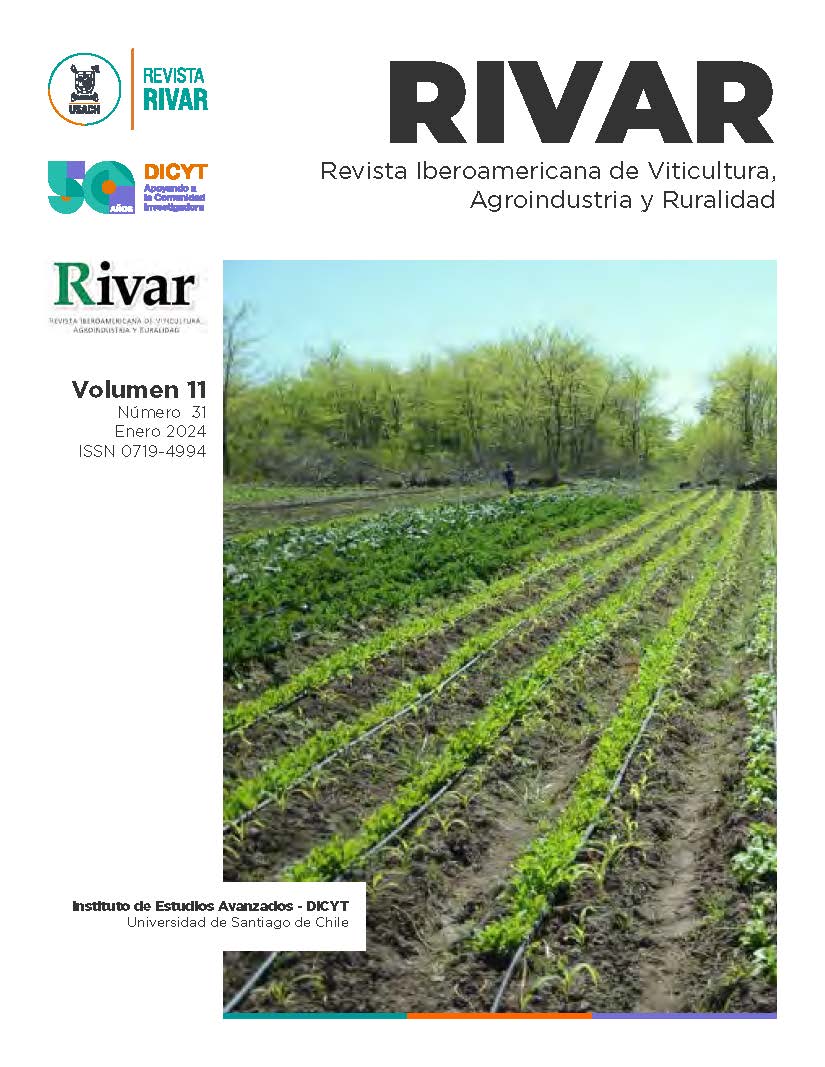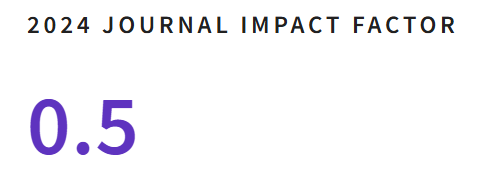Toxicity of Nettle Slurry on Two Free Living Nematodes
DOI:
https://doi.org/10.35588/rivar.v10i31.6173Keywords:
nettle slurry, free-living nematodes, ecotoxicity, biopreparation, Caenorhabditis elegansAbstract
Biopreparations represent an important alternative to the use of synthetic agrochemicals. Among them, nettle slurry (Urtica sp.) is used as a biostimulant and in the control of pests and diseases. However, there is no information on its effects on non-target organisms of the agroecosystem. The objective of this work was to study the lethal effects of different dilutions of nettle slurry on the free-living model nematodes Caenorhabditis elegans and Panagrellus redivivus (key organisms in the soil structure). Five toxicity bioassays were carried out in a liquid medium on C. elegans and one on P. redivivus. Three nettle slurries with different processing conditions and storage times were used. The slurry proved to have lethal effects on C. elegans individuals depending on the dilution of exposure. The information obtained on the ecotoxicity of biopreparations can contribute to the optimization of horticultural practices.
Downloads
References
Altieri Soto, M.A. y Nicholls, C.I. (2000). Agroecología: Teoría y práctica para una agricultura sustentable. Programa de las Naciones Unidas para el Medio Ambiente y Red de Formación Ambiental para América Latina y el Caribe.
Ayala, H., Iannacone, J. y Alvariño, L. (2017). Toxicity of Five Botanical Aqueous Extracts on Panagrellus redivivus (Nematoda: Panagrolaimidae), Daphnia magna (Crustacea: Daphniidae), Lemna minor (Araceae) and Raphanus sativus (Brassicaceae). Neotropical Helminthology, 11(1), 139-155.
Braeckman, B., Houthoofd, K. y Vanfleteren, J. (2009). Intermediary Metabolism. WormBook: The Online Review of C. Elegans Biology. https://www.ncbi.nlm.nih.gov/books/NBK116085/
Chimento, L., Simontacchi, M. y Maydup, M. L. (2019). Efectos del uso de un biopreparado a base de ortigas sobre el crecimiento de plantas de lechuga. Investigación Joven, 6(2), 56.
Cong, Y., Yang, H., Zhang, P., Xie, Y., Cao, X. y Zhang, L. (2020). Transcriptome Analysis of the Nematode Caenorhabditis elegans in Acidic Stress Environments. Frontiers in Physiology, 11, 1107. https://doi.org/10.3389/fphys.2020.01107
Domenico, P. (2019). Bat Guano and Nettle Slurry (Urtica dioica L.) Used as Biostimulants on Delosperma cooperi and Sedum rubrotinctum Plants. World Journal of Advanced Research and Reviews, 3(2), 17-23. https://doi.org/10.30574/wjarr.2019.3.2.0058
Garmendia, A., Raigón, M.D., Marques, O., Ferriol, M., Royo, J. y Merle, H. (2018). Effects of Nettle Slurry (Urtica dioica L.) Used as Foliar Fertilizer on Potato (Solanum tuberosum L.) Yield and Plant Growth. PeerJ, 6, e4729. https://doi.org/10.7717/peerj.4729
Gliessman, S.R., Rosado-May, F.J., Guadarrama-Zugasti, C., Jedlicka, J., Cohn, A., Méndez, V.E., Cohen, R., Trujillo, L., Bacon, C. y Jaffe, R. (2007). Agroecología: Promoviendo una transición hacia la sostenibilidad. Ecosistemas, 16(1), 13-23.
Hayashi, M. y Wharton, D.A. (2011). The Oatmeal Nematode Panagrellus redivivus Survives Moderately Low Temperatures by Freezing Tolerance and Cryoprotective Dehydration. Journal of Comparative Physiology B, 181(3), 335-342. https://doi.org/10.1007/s00360-010-0541-3
Lovatto, P.B., Mauch, C.R., Lobo, E.A. y Schiedeck, G. (2016). Avaliação de Pteridium aquilinum (Dennstaedtiaceae) e Urtica dioica (Urticaceae) como alternativas ao equilíbrio populacional de afídeos em cultivos orgânicos no sul do Brasil. Revista de la Facultad de Agronomía, 115(2), 265-271.
Mamani de Marchese, A. y Filippone, M.P. (2018). Bioinsumos: Componentes claves de una agricultura sostenible. Revista Agronómica del Noroeste Argentino, 38(1), 9-21.
Maričić, B., Radman, J., Major, N., Urlić, B., Palčić, I., Ban, D., Zorić, Z. y Ban, S. G. (2021). Stinging Net (Urtica dioica L.) as an Aqueous Plant-Based Extract Fertilizer in Green Bean (Phaseolus vulgaris L.) Sustainable Agriculture. Sustainability, 13(7), 4042. https://doi.org/10.3390/su13074042
Molpeceres, C., Zulaica, L. y Tomaino, V.B. (2023). Cuestionamientos al uso de agroquímicos en Argentina y el mundo (2000-2020): Una revisión. Novum Ambiens, 1(1), e2340. https://doi.org/10.31910/novamb.v1.n1.2023.2340
Nasiri, M., Azizi, K., Hamzehzarghani, H. y Ghaderi, R. (2014). Studies on the Nematicidal Activity of Stinging Nettle (Urtica dioica) on Plant Parasitic Nematodes. Archives of Phytopathology and Plant Protection, 47(5), 591-599. https://doi.org/10.1080/03235408.2013.816080
Ortega, R.N., Alban, R. y Alfonzo, D. (2009). Los purines a base de ortiga (Urtica dioica) una alternativa natural en el control de insectos del orden Coleoptera. Revista Brasileira de Agroecologia, 4(2), 2353-2355.
Pica Granados, Y. (2008). Ensayo de toxicidad con el nemátodo Panagrellus redivivus. En P.R. Romero y A.M. Cantú (Comps.), Ensayos toxicológicos para la evaluación de sustancias químicas en agua y suelo: La experiencia en México (pp. 139-154). SEMARNAT.
Price Masalias, L.J. y Merztal, G. (2010). Biopreparados para el manejo sostenible de plagas y enfermedades en la agricultura urbana y periurbana. Ipes/Fao, 24. http://www.fao.org/3/a-as435s.pdf
Ritz, C., Baty, F., Streibig, J.C. y Gerhard, D. (2015). Dose-Response Analysis Using R. PLOS ONE, 10(12), e0146021. https://doi.org/10.1371/journal.pone.0146021
Salas, A. y Achinelly, M.F. (2020). Community Structure of Soil Nematodes Associated with the Rhizosphere of Solanum lycopersicum in a Major Production Area in Argentina: A Case Study among Agroecosystem Types. Journal of Soil Science and Plant Nutrition, 20(1), 43-54. https://doi.org/10.1007/s42729-019-00099-8
Salas, A., Achinelly, M.F. y Sauka, D.H. (2021a). Nematicidal Effect of an Argentine Strain of Photorhabdus laumondi laumondi (Enterobacteriaceae) on the Free-living Nematode Panagrellus redivivus (Rhabditidae: Panagrolaimidae). Revista Argentina de Microbiología, 53(1), 84-85. https://doi.org/10.1016/j.ram.2020.04.002
Salas, A., Barrera, M.D. y Achinelly, M.F. (2021b). Abundance, Diversity, and Distribution of Plant-parasitic Nematodes in Horticultural Soils under Different Management Systems in a Tomato-producing Area in Argentina. Nematology, 24(3), 347-356. https://doi.org/10.1163/15685411-bja10136
Salas, A., Rusconi, J.M., Rocca, M., Lucas, F.D., Balcazar, D. y Achinelly, M.F. (2022). A New Wild Strain of Caenorhabditis Elegans Associated with Allograpta exotica (Syrphidae) in Argentina: An Update of its Ecological Niche and Worldwide Distribution. Anais da Academia Brasileira de Ciências, 94(3), e20201440. https://doi.org/10.1590/0001-3765202220201440
Sarandon, S.J. y Marasas, M.E. (2015). Breve historia de la agroecología en la Argentina: Orígenes, evolución y perspectivas futuras. Agroecología, 10(2), 93-102.
Sochová, I., Hofman, J. y Holoubek, I. (2007). Effects of Seven Organic Pollutants on Soil Nematode Caenorhabditis elegans. Environment International, 33(6), 798-804. https://doi.org/10.1016/j.envint.2007.03.001
Stiernagle, T. (2006). Maintenance of C. elegans. En D. Fay (Ed.), WormBook (pp. 1-11). The C. elegans Research Community.









